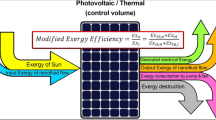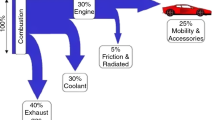Abstract
Twenty-first century research has always sought to use waste gases from diesel engine exhaust. Exhaust gases from floating diesel engines can be a good source of energy for power generation. The electricity generated by thermoelectric modules can contribute to the generator power of floating diesel generators. The prototypes of thermoelectric generators have been developed and advanced.But there are still issues such as: the thermal stability of thermoelectric materials, proper design of heat exchangers with high heat absorption capacity from the exhaust, and utilizing nanofluids with different concentrations in heat exchangers; needs more studies. On the other hand, utilizing Cu2O nanofluids in thermoelectric generators has not been investigated. In this research, a thermoelectric generator kit model consisting of twenty-four thermoelectric modules is designed and installed on the exhaust (replacing the expansion-expansion tube of a diesel generator) which in their heat-exchangers, water-copper oxide (Cu2O) nanofluid is used for more cooling. The functional parameters of the thermoelectric generator kit in open and closed electrical system as a function of nanofluid volumetric concentration are studied. The innovation of the kit is the compact rectangular design of a thermoelectric generator kit with aluminum blocks as water and Cu2O-water nanofluid at 0.2% volume concentration coolers, which is integrated with the regulator and rheostat circuit to achieve the maximum generating capacity of the generator. The results are plotted as graphs of voltage, current, generating power and thermal efficiency in terms of different engine speeds and different temperature differences and different volumetric flow rates of the cooling fluid in both open and closed circuit modes. The results revealed that in open circuit mode; as the temperature difference applied to the sides of the modules increases, both the open circuit voltage and the short circuit current increase almost linearly. In the maximum temperature difference, the open circuit voltage and short circuit current for nanofluid cooling with 0.2% volume concentration compared to the water cooling has increased by 6.1 and 5.4%, respectively. In closed circuit mode (active rheostat); as the ratio of load resistance to modulus resistance increases, the current to maximum current ratio decreases, the voltage to maximum voltage ratio increases, and the power to maximum power ratio has an optimal state for water cooling and Cu2O-water nanofluid cooling. In addition, when the hot side of the thermoelectric modules is 185 °C, with the increase in volumetric flow rate from 2 to 4 L min−1, the open circuit voltage increases from 34.9 to 39.1 V, and the value of the short circuit current increases from 6.6 to 7.2A. Also at engine speed of 1300 RPM and volumetric flow rate of 2 L min−1, By adding 0.2% volume concentration of nanoparticles to water in cooling system of thermoelectric kit, the maximum power output is increased by about 9.5%.




























Similar content being viewed by others
References
Farret FA, Simoes MG. Antegration of alternative source of energy. John Wily and Sons; (2006).
Farmer JR (2007) A comparison of power harvesting techniques and related energy storage issues. MS Thesis, Dept. Mech. Eng. Virginia polytechnic institute and State Unive. Blacksburgs
Nolas G, Sharp J, Goldsmid H. Thermoelectric: basic princples and new material developments. New York: Springer; 2001.
Bell L. Cooling, heating, generating power and recovering waste heat with thermoelectric systems. Sci. 2008;321:1457–61.
Lee H (2016) Thermoelectrics- design and materials. John Wiley and Sons
Wang CC, Hung CI, Chen WH. Design of heat sink for improving the performance of thermoelectric generator using two-stage optimization. Energy. 2012;39:236–45.
Disalvo F. Thermoelectric cooling and power generation. Sci. 1999;285:703–6.
Owen A (2012) Embedded thermoelectric devices for one chip cooling and power generation. MS Thesis, Georgia Institued of Technology
Wu C. Analysis of waste heat thermoelectric power generation. Appl Therm Eng. 1996;16:63–9.
Thacher E, Helenbrook B, Karri M, Richter C. Testing of an automobile exhaust thermoelectric generator in a light truck. Automot Eng Int. 2007;221:95–107.
Birkholz U, Grog R, Stohrer U, Voss K (1988) Conversion of waste exhaust heat in automobile using FeSi2 thermoelements. Proc Int Conf Eng Sci Appl Thermoelectric Energy Convers. 124.
Bass J, Elsneer NB, Leavitt A. Performance of the 1 kW thermoelectric generator for diesel engines. New York: Proc Int Conf Thermoelectrics; 1995.
Kobayashi M, Ikoma K, Furuya K, Shinohara K, Takao H, Miyoshi M, Imanishi Y, Watanabe T. (1996) Thermoelectric generation and related properties of conventional type module based on Si–Ge alloys. In: Proc 15th Int Conf Thermoelectrics. California.
Ikoma K, Munekiyo M, Furuya K, Izumi T, Shinohara K. (1998) Thermoelectric module and generator for gasoline engine vehicles. In: Proc 17th Int Conf Thermoelectrics. Nagoya Trade and Industry Center, Japan.
Elsner NB, Bass JC, Ghamaty S, Krommenhoek D, Kushch A. Program diesel truck thermoelectric generator. Final Report: Hi-Z Technology Inc.; 2005.
Lagrandeur J, Crane D, Eder A. (2005) Vehicle fuel economy improvement through thermoelectric waste heat recovery. In: Proc 11th Diesel Eng Emiss Reduct (DEER) Conf. Chicago.
LaGrandeur J, Crane D, Hung S, Mazar B, Eder A. (2006) Automotive waste heat conversion to electric power using skutterudite, TAGS, PbTe and BiTe. 25th Int Conf Thermoelectrics, ICT'06. Vienna.
Fairbanks J (2008) Vehicular applications of thermoelectrics. Diesel Eng Emiss Reduct (DEER) Conf. Michigan.
Rowe DM. International Thermoelectric Society. Available: http://www.its.org/node/5682. 2008.
Meisner G (2011) Thermoelectric conversion of exhaust gas waste heat into usable electricity. In: Directions in Engine-Efficiency and Emissions Research (DEER) Conf. Detroit, Michigan.
Business Wire. GMZ energy announces 1000 Watt high-temperature thermoelectric generator for U.S. Military. Available: http://www.businesswire.com/news/home/20141203005186/en/GMZ-Energy. 2015.
Bai S, Lu H, Wu T, Yin X, Shi X, Chen L. Numerical and experimental analysis for exhaust heat exchangers in automobile thermoelectric generators. Case Stud Therm Eng. 2014;4:99–112.
Peiravi MM, Alinejad J. Hybrid conduction, convection and radiation heat transfer simulation in a channel with rectangular cylinder. J Therm Anal Calorim. 2020;140:2733–47.
Alinejad J, Abolfazli EJ. Lattice Boltzmann simulation of forced convection over an electronic board with multiple obstacles. Heat Transf Res. 2014;45:241–62.
Alinejad J, Abolfazli EJ. Numerical stabilization of three-dimensional turbulent natural convection around isothermal cylinder. J Thermophys Heat Transf. 2015. https://doi.org/10.2514/1.T4563.
Peiravi MM, Alinejad J. 3D numerical simulation of fibers arrangement effects on thermal conductivity of polymer matrix composite. Mech Adv Compos Struct. 2022;9:52–73.
Pourziaei Araban H, Alinejad J, Peiravi MM. Entropy generation and hybrid fluid-solid-fluid heat transfer in 3D multi-floors enclosure Int. J Exergy. 2022;37:337–52.
Alinejad J, Abolfazli EJ. Taguchi design of three dimensional simulations for optimization of turbulent mixed convection in a cavity. Meccanica. 2017;52:925–38.
Yu C, Chau KT. Thermoelectric automotive waste heat energy recovery using maximum power point tracking. Energy Conver Manage. 2009;50:12–5.
Stuban N, Torok A. (2009) Utilization of exhaust gas thermal energy–Theoretical investigation. In: Conf Warsaw. 268–272.
Birkholt U (1988) Conversion of waste exhaust heat in automobiles using FeSi2 Thermoelements. In: Proc 7th Int Conf Thermoelectrics Energy Convers. Arlington, TX, USA. 16–18.
Ikoma K, Munekiyo M, Furuya K, Kobayashi M, Izumi T, Shinohara K. Thermoelectric module and generator for gasoline engine vehicles. Institute of Electrical and Electronics Engineers (IEEE): Piscataway, NJ, USA; 2002. p. 464–7.
Ikoma K, Munekiyo M, Furuya K, Kobayashi M, Komatsu H. Thermoelectric generator for gasoline engine vehicles using Bi2Te3 modules. J Jpn Inst Met. 1999;63:1475–8.
Bass JC, Elsner NB, Leavitt FA. Performance of the 1 kW thermoelectric generator for diesel engines. Proc AIP Confe AIP Publishing: Melville, NY, USA. 1994;316:295–8.
Crane D, LaGrandeur J, Jovovic V, Ranalli M, Adldinger M, Poliquin E, Dean J, Kossakovski D, Mazar B, Maranville C. TEG on-vehicle performance and model validation and what it means for further TEG development. J Electron Mater. 2012;42:1582–91.
Crane DT, LaGrandeur JW. Progress report on BSST-Led US department of energy automotive waste heat recovery program. J Electron Mater. 2009;39:2142–8.
Bell LE, LaGrandeur JW, Crane DT. Progress report on vehicular waste heat recovery using a cylindrical thermoelectric generator. Thermoelectr Goes Automot. 2010;2:83–91.
Meisner GP. (2011) Advanced thermoelectric materials and generator technology for automotive waste heat at GM. In: Proc 2nd Int Conf Thermoelectrics. ApplicationsWorkshop, San Diego, CA, USA.
Kumar S, Heister SD, Xu X, Salvador JR, Meisner GP. Thermal design of thermoelectric generators for automobile waste heat recovery. ASME Int: New York, NY, USA. 2012;1:67–77.
Magnetto D. First light commercial vehicle equipped with a TEG. Darmstadt, Germany: Proc Int Conf Thermal Manage EV/HEV; 2013.
Bonader WB. Thermoelectric generator optimization for hybrid electric vehicles. Appl Therm Eng. 2020;167: 114761.
Shen ZG, Tian LL, Liu X. Automotive exhaust thermoelectric generators: Current status, challenges and future prospects. Energy Convers Manag. 2019;195:1138–73.
Smith TWP, Jalkanen JP, Anderson BA, Corbett JJ, Faber J, Hanayama S, O’Kee E, Parker S, Johanasson L, Aldous L. Third IMO GHG Study. International Maritime Organization: London, UK; 2015.
Champier D. Thermoelectric generators: A review of present and future applications. Cham, Switzerland: Springer Proc Energy; Springer Science and Business Media LLC; 2016. p. 203–12.
Loupis M, Papanikolaou N, Prousalidis J (2013) Fuel consumption reduction in marine power systems through thermoelectric energy recovery. In: Proc 2nd.MARINELIVE Conf Electric Ship. Athens, Greece.1–7.
Kim TY, Negash AA, Cho G. Waste heat recovery of a diesel engine using a thermoelectric generator equipped with customized thermoelectric modules. Energy Convers Manage. 2016;15(124):280–6.
Mohd Noor HMH, Muhammad FR, Baljit S, Nor Dalila NA. Thermoelectric power generations from vehicle exhaust gas with TiO2 nanofluid cooling. Therm Sci Engineering Prog. 2020;18:100558.
He RHX, Wang J, Liao J, Sun L, Gao M, Li C. Numerical investigation and comparative analysis of nanofluid cooling enhancement for TEG and TEC systems. Case Stud Therm Eng. 2021;27: 101331.
Kirkup L, Frenkel R. An introduction to uncertainty in measurement using the GUM (Guide to the Expression of Uncertainty in Measurement). 1st ed. Cambridge: Cambridge University Press; 2006.
Seebek T. Magnetic polarization of metals and minerals. Abhandlungen der Deutschen Akademie der Wissenschaften zu Berlin. 1822;265:182.
Anatychuk LI, Razinkov RR, Rozver YY, Mikhailovsky VY (1997) Thermoelectric generator modules and blocks, In: Proc Int Conf Thermoelectrics. 592–594.
Mahan GD. Figure of merit for thermoelectric. J Appl Phys. 1989;65:1578–83.
Acknowledgements
The authors like to thank Dr Shapour Ebrahimi and Dr Hamed Samdakiri for their assistance (reviewing and editing) of the paper.
Author information
Authors and Affiliations
Corresponding author
Additional information
Publisher's Note
Springer Nature remains neutral with regard to jurisdictional claims in published maps and institutional affiliations.
Rights and permissions
Springer Nature or its licensor (e.g. a society or other partner) holds exclusive rights to this article under a publishing agreement with the author(s) or other rightsholder(s); author self-archiving of the accepted manuscript version of this article is solely governed by the terms of such publishing agreement and applicable law.
About this article
Cite this article
Ashkezari, A.Z., Karimi, R. & Abbaspour, I. Application of exhaust heat dissipation in improving the performance of diesel generators via thermoelectric generator kit accompanied by Cu2O-water nanofluid. J Therm Anal Calorim 149, 2499–2520 (2024). https://doi.org/10.1007/s10973-023-12807-9
Received:
Accepted:
Published:
Issue Date:
DOI: https://doi.org/10.1007/s10973-023-12807-9




